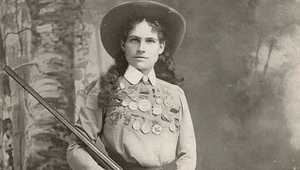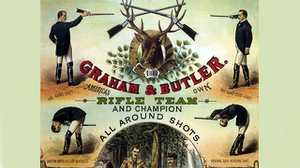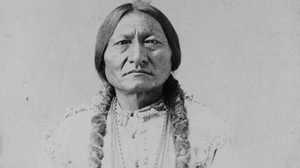In a Man's World

Annie Oakley's life spanned years of tremendous change for American women. By the time of her death in 1926, Americans were celebrating the liberated, urban-focused, modern times of the Jazz Age. Women had won the right to vote, wore less restrictive clothes, and followed a changing ideal that was loosening some of the restrictions on women's roles and behavior that had reigned through the 19th century.
Though she excelled in shooting, a sport that was traditionally a male domain, Annie Oakley did not align herself with the feminists of her day. Program interviewees Paul Fees, Shirl Kasper, Joy Kasson, Virginia Scharff, Mary Zeiss Stange, Elliott West, and R. L. Wilson explore Annie Oakley's attitude toward women's issues.
Questions
How would you characterize the changes for women during Oakley's lifetime?
Shirl Kasper, Biographer: She's born before the Civil War. She's born in the Victorian era. And she lives into the modern area, 1926. So much changes during her life. She is a Victorian woman. And yet she seems like a modern woman. She's kind of both... All kinds of things are happening in America. The Industrial Age has come. We're getting all kinds of new machines. We're getting telephones and we're getting sewing machines and we're getting movies, and women are parading for their political rights... Gender expectations are changing. You know, in the Victorian era... women are supposed to be true women. They're supposed to be pious and pure and domestic. They stay home. The husband goes out into the world.
Elliott West, Historian: During the late 19th century there were of course women who could be seen on the streets carrying placards and holding conventions for women's rights, advocating greater participation of women in all areas of American life. And there were women, of course, who conformed to a Victorian image, women corseted and always on the verge of a swoon. But most women, as common sense would tell you, fell in between those two extremes. Most women were also caught up in these changes and so that meant, I think, that most women were trying to decide exactly where they stood on the spectrum between those two poles asking themselves what they thought about this, how they felt about this. And what someone like Annie Oakley did was give them an image of someone who really fell between those two poles, who could be seen as reflected in both of those two extremes. Someone therefore that these women could identify with.
Was it forward-thinking for Buffalo Bill to hire a woman shooter?
Paul Fees, Historian: Before Annie Oakley was hired for the Wild West show, there were no acts that incorporated women. There were no narrative elements that featured women... Annie Oakley paved the way. The presence of a strong woman -- that is, a western woman, a self-reliant woman -- allowed the show to begin to experiment with narrative elements such as the attack on the settlers' cabin, to make use of one of the strongest American narrative myths, the myth of captivity, and to allow women to begin to show themselves as strong, self-reliant, western, to begin to show themselves as capable of competing with and working with men.
Joy Kasson, Historian: I think the idea of a woman shooter, before Annie Oakley, might have seemed to be more along the lines of the freak show. As Dr. Johnson famously said about the dog that walks on its hind legs -- it's not whether it does it well --it's that it does it at all.
Virginia Scharff, Historian: Annie Oakley was a self-made woman and a self-made American if ever there was one. This is somebody who triumphed over the most horrible childhood you could imagine, picked up a gun and made her fortune first as a market hunter, and then as an entertainer. She understood the importance of marketing herself. And so when it came to joining the Wild West and dealing with Buffalo Bill, there was probably never a woman in the history of the U.S. who was better equipped to take up the challenge of creating a legend, of creating a myth of the western woman and then embodying that myth with the kind of lady-like demeanor that would make her acceptable.
Did Oakley use sex appeal in her act?
Paul Fees, Historian: Annie Oakley managed to combine both demureness and voluptuousness in her costume... She never showed any skin. Her ankles were never bare. But her costumes were form-fitting. She wore leggings under short skirts, so people could see the shape of her legs as she ran out into the arena... She was, in that sense, appealing to the best instincts in the men in her audience, men who were attracted to her sexuality while still not having to feel guilty about being attracted, because at the same time she was ladylike and she was demure...
Joy Kasson Historian: She made her own costumes. That was very important to her. Was part of her desire to control her self-presentation. And if you look at those pictures carefully, you see the skirts are shorter than .. grownup women would have worn on the street. But that's because she was an athlete. She was active. She had the short skirt, the bodice, the loose bodice. She had fringes. She had clothing that suggested the West. It was often made of something practical, like cotton. But she sewed them herself. She could move easily in them, and yet she looked respectable. She looked childlike. She looked very attractive. She wore her hair down. That plus her small stature -- she was only about five feet tall -- made her look like a child. And I think that part of her self-presentation as this skilled woman marksman was that she was at the same time sweet and non-threatening. She had the little pout and the little kick that she gave as part of her act. And her clothing was the marker that she was both an athlete but also a charming little girl.
How did Oakley exemplify both traditional and modern women's roles?
Shirl Kasper, Biographer: Annie Oakley's] roles in the marriage were inverted. Annie was earning the bread. Frank was the secretary, managing, cleaning her guns, fixing up her schedule. Their roles are reversed. Annie does have the man's role, the same as she did when she was a kid, paying off the mortgage on her mom's house. That's what her father should have done. But of course he was dead. So she did take on this manly role, even though she seemed so feminine. She did have the manly role, and Frank took a back seat, which traditionally is the woman's role.
Elliott West, Historian: When the First World War came along she offered to raise a regiment of women to fight in that war... as she had done in the Spanish American War. She offered to teach soldiers how to shoot. She raised money for the war itself, she raised money for things like the YMCA, she became a kind of a public figure and almost a public activist in those ways. And yet at the same time she continued to not just to advocate but to live out the role of the proper wife.
Mary Zeiss Stange, Professor of Women's Studies: On the one hand, she is the trailblazer who is shattering stereotypes about appropriate feminine behavior, and yet on the other hand, she is a very proper Victorian lady... She was such a revolutionary figure in terms of being a media superstar, if you will. She could not only out-shoot men -- she was out-earning most men of her time. And there are only so many gender roles that one person can break. And so I think in that regard... she felt it was very necessary for her to be appropriate feminine and traditional in a number of recognizable ways.
Paul Fees, Historian: She was bold, and yet she was reserved. She was sensual and girlish, but she was never coy. So I think that what she projected was a vitality and freshness that for many people came to stand for American womanhood. It's what made American women attractive -- that outdoor complexion, that wonderful figure, and yet that carriage, that demureness, that suggested that she was in charge of herself and not to be had.
Why did Oakley encourage women to learn to shoot?
Shirl Kasper, Biographer: She overhears a woman talking, "I wish I could learn to shoot a gun." And Annie goes up to her and says, "I'll teach you." This is the first time in her life, it seems, that she really starts to make women friends... And I think she takes great delight in teaching these women how to use a gun. She says she teaches 15,000 women over the years.
Mary Zeiss Stange, Professor of Women's Studies: In Annie's time, a fair number of women were taking up hunting, especially after Theodore Roosevelt and [Gifford] Pinchot and company really started working hard to promote the idea of sport hunting as an appropriate activity for middle-class women as well as men. Interestingly enough, editors of outdoor magazines at that time argued that it would be good to take your wife hunting and shooting, because then she wouldn't be bothering her sweet little head with things like politics. Some people actually saw hunting as a nice sort of outlet that was much healthier than, for example, arguing for women's suffrage.
R. L. Wilson, Firearms Historian: Annie was comfortable with the way she was. She loved to shoot and she loved to ride and she liked to do all these athletic things. And she was also gifted at encouraging other people to do it.
How did Oakley feel about the women's suffrage movement?
Mary Zeiss Stange, Professor of Women's Studies: Oakley, for a variety of personal and perhaps professional reasons, did not ally herself with the feminist movement of her time. She didn't argue for—in fact, she explicitly argued against—women's suffrage. She didn't argue for the kinds of things that the so-called "new women" of her day were arguing for. But interestingly, and ironically, in a sense, she was living a lot of the things that her feminist sisters were arguing for. And in some ways, she was also arguing for some of the same things they were, especially with regard to equal pay for equal work. She was an early proponent of that... In a sense, Annie was rather like the kind of women that you hear still today, who say, "I'm not a feminist, but I believe in equal rights for women—I believe in equal pay for women."
Shirl Kasper, Biographer: People are always shocked when I say Annie didn't want women to vote. They're like, "How can that be? Certainly she was a feminist." But she wasn't political in that way.
Virginia Scharff, Historian: We wonder how someone who taught women shooting classes, who encouraged women to be self reliant, who encouraged them to aspire to greatness, could possibly, under any circumstances, have opposed a woman's right to vote. I can't figure it out, all I can figure is that she thought this was going to be bad publicity for her—that this is fundamentally somebody who is in certain regards culturally conservative and not somebody who wanted to go out on a limb, and take a controversial stand. I think she thought that coming out for the woman's vote might be bad marketing and that's all I can figure, because otherwise there's absolutely no reason why she would have been against women's right to vote... She understood that her public consisted of people who were both for and against women's suffrage and she did not want to risk alienating anybody who might buy a ticket to the show.
What is Oakley's legacy?
Shirl Kasper, Biographer: I think Annie's image has changed over time... She comes to represent not maybe who she was, but... this West of freedom and independence... We embrace her because of what she represents to us, even though it might not be totally accurate. We want her to be a feminist, even if she wasn't, because she seems that way, and we need her to be.
Mary Zeiss Stange, Professor of Women's Studies: Annie Oakley is one of the first images available to the American populace-at-large of what a powerful woman could look like, especially to the extent that guns were associated with power. And in American society, we've been called a gunfighter nation. Guns have always symbolized being powerful and knowing how to use power. In that regard, she's a very significant figure and a trailblazer.
R. L. Wilson, Firearms Historian: Annie Oakley showed that a woman could do things that a man could do—that she could do it in a way that wasn't threatening to a man—that she could become a international celebrity, doing this—that she could be athletic—that she could exert herself—and that she could make a career for herself that people at that time could never imagined have been done by a woman.







